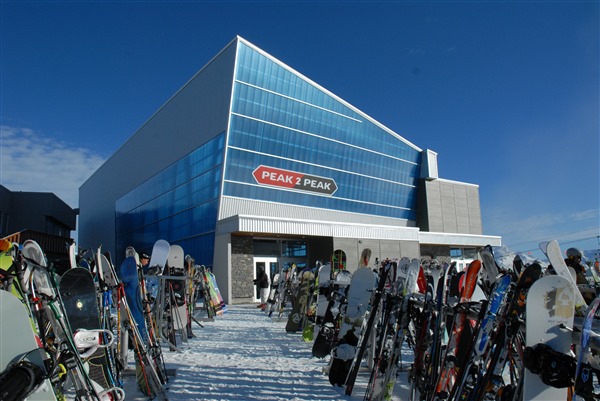PEAK 2 PEAK Gondola Terminal Project delivered on Schedule, on Budget
When asked if he would recommend BEHLEN Industries LP (BEHLEN) to others, Colony Buildings (Colony) president, David Thompson, answered quickly, “Absolutely. Except to my competition.”
In fact, Colony may have missed out on the PEAK 2 PEAK gondola terminal project, where it built one of Canada’s iconic sports structures, if it weren’t for BEHLEN’s cost effective and versatile pre-engineered steel buildings.
“Working with Colony and the project designers during the PEAK 2 PEAK project, we were able to keep the original design very similar while drastically lowering the budget for the building by changing the style to pre-engineered steel,” said BEHLEN’s Pat Versavel, Vice President Engineering and Innovation. “Typically, pre-engineered steel buildings are perceived by the construction community as looking boxy. That perception just isn’t accurate. I think we proved with the PEAK 2 PEAK project that pre-engineered buildings can have skewed walls and compound angles and still be much cheaper than their conventional steel counterparts.”
The PEAK 2 PEAK gondola terminals became an essential feature in the alpine skyline of the 2010 Vancouver Olympic games and are still a major tourism draw. The 24,000 square foot structures are an entry point for visitors wishing to ride the highest gondola in the world, which runs between the Whistler Mountain and Blackcomb Mountain in British Columbia.
During the lead up to the Olympics, Intrawest, the mountain resort and adventure company in charge of the project, hired architectural firm CannonDesign (Cannon) to design the gondola terminals. Everyone wanted something unforgettable, but it became clear that the cost of the iconic conventional steel buildings they sketched exceeded their budget.
Intrawest was under pressure to come up with a solution that would elegantly connect Blackcomb Mountain with the amenities at the top of Whistler Mountain. Should they make the buildings less iconic to save money or keep them as they were and make other sacrifices?
Intrawest called in Colony to help, and Colony turned to BEHLEN.
“It was very important that the building itself be very iconic,” said Thompson. “The moment I looked at the structure I developed a concept in my mind of how it could be built and remain iconic while drastically reducing the budget.”
Instead of hiding the steel structure behind a façade, Cannon designed the terminals to embrace its steel structure, using translucent panels to show the beams inside the walls. With help from BEHLEN, Colony was able to keep the spirit of the original building, while converting the architect’s conventional steel design into a pre-engineered hybrid building which was much more cost efficient.
“When Colony approached us and described their idea for the terminals’ design we knew we wanted to be involved with the project,” said Versavel. “This was a chance for us to have a big part in creating an iconic structure and to show that our system of pre-engineered buildings legitimately can save money when compared apples to apples with conventional steel buildings.”
The new design was embraced by Cannon, who appreciated that Colony and BEHLEN respected the original design concept and were enthusiastic about being involved in such a unique project.
“We had the design well developed as kind of a conventional steel building before Colony came on board and we had to make a few compromises, but it wasn’t a dumbing down of the project, it was kind of streamlining of the design…a very good collaboration,” said Christopher Rowe, Cannon’s vice president.
With the new pre-engineered design. the project’s cost dropped significantly, allowing it to be completed on budget. BEHLEN manufactured the buildings in its Brandon, Manitoba plant and shipped it in pieces to the mountain top construction sites where Colony put it up.
“It certainly was the partnering with BEHLEN that was the deciding factor on the project,” said Thompson. “We couldn’t have done it with anyone else.”
The altitude, high snow loads and strong winds made both engineering and building the terminals difficult. Despite the conditions and weather delays in preparing the foundation, Colony was able to erect the buildings on schedule.
“Creating the terminals for the PEAK 2 PEAK gondola was an honour for us,” said Versavel. “We love how the building design showcased its steel structure while being unique, modern and beautiful. I think this project proves that steel buildings don’t have to look like boxes and that our engineers are capable of working with almost any design to achieve our customers’ visions.”
Intrawest’s John R. Morley, vice president of development said that Colony and BEHLEN were able to answer design and budgeting questions very quickly, allowing Intrawest to explore its options and make the best decisions.
“I guess the deciding factor was primarily that Colony was able to deliver the building that everybody wanted within our budget and the added bonus to that was the ability to work with us to fine tune the design and I think improve the building,” he said in a testimonial.
Today the gondola buildings are internationally recognized structures as an architectural, engineering and construction feat.
